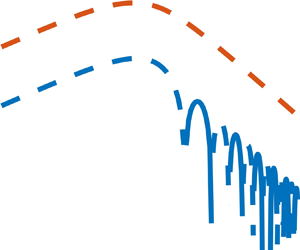Published online by Cambridge University Press: 12 April 2024

We study the statistically steady states of the forced dissipative three-dimensional homogeneous isotropic turbulence at scales larger than the forcing scale in real separation space. The probability density functions (p.d.f.s) of longitudinal velocity difference at large separations are close to, but deviate from, Gaussian, measured by their non-zero odd parts. The analytical expressions of the third-order longitudinal structure functions derived from the Kármán–Howarth–Monin equation prove that the odd-part p.d.f.s of velocity differences at large separations are small but non-zero. Specifically, when the forcing effect in the displacement space decays exponentially as the displacement tends to infinity, the odd-order longitudinal structure functions have a power-law decay with an exponent of  $-$2, implying a significant coupling between large and small scales. Under the assumption that forcing controls the large-scale dynamics, we propose a conjugate regime to Kolmogorov's inertial range, independent of the forcing scale, to capture the odd parts of p.d.f.s. Thus, dynamics of large scales departs from the absolute equilibrium, and we can partially recover small-scale information without explicitly resolving small-scale dynamics. The departure from the statistical equilibrium is quantified and found to be viscosity-independent. Even though this departure is small, it is significant and should be considered when studying the large scales of the forced three-dimensional homogeneous isotropic turbulence.
$-$2, implying a significant coupling between large and small scales. Under the assumption that forcing controls the large-scale dynamics, we propose a conjugate regime to Kolmogorov's inertial range, independent of the forcing scale, to capture the odd parts of p.d.f.s. Thus, dynamics of large scales departs from the absolute equilibrium, and we can partially recover small-scale information without explicitly resolving small-scale dynamics. The departure from the statistical equilibrium is quantified and found to be viscosity-independent. Even though this departure is small, it is significant and should be considered when studying the large scales of the forced three-dimensional homogeneous isotropic turbulence.